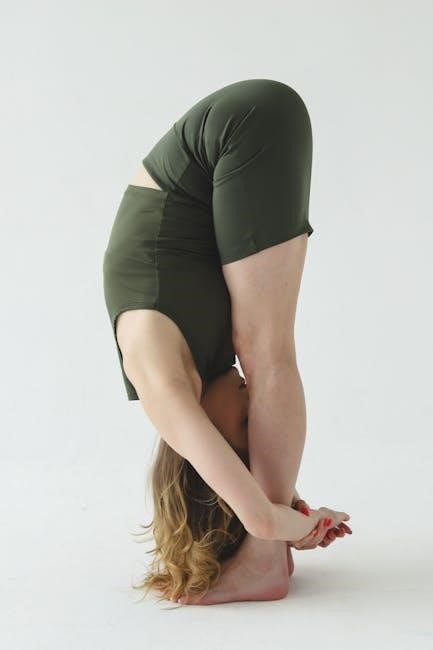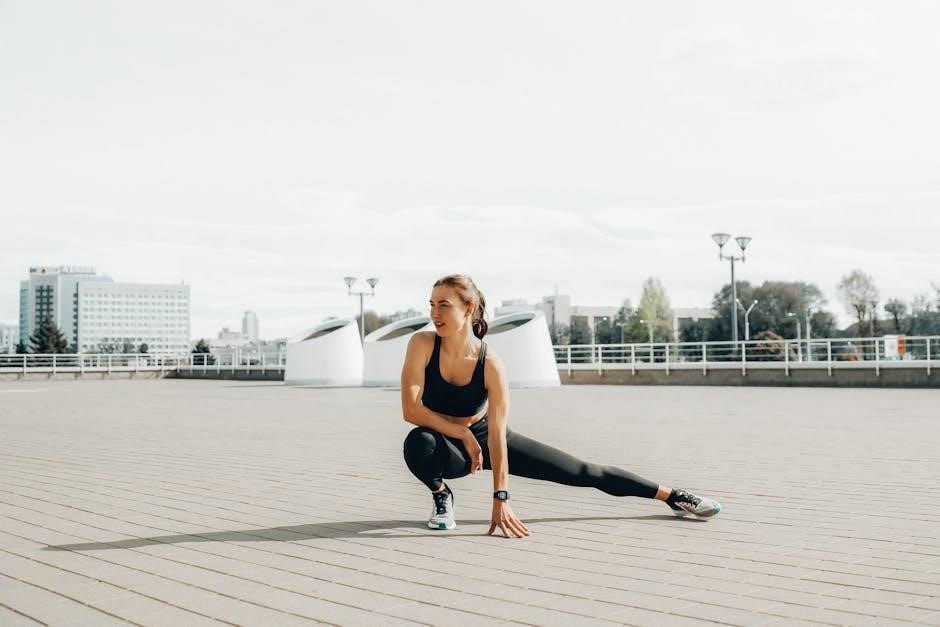Prison workout routines are high-intensity, bodyweight-based exercises developed in correctional facilities. They rely on minimal equipment and creative variations, focusing on strength, endurance, and mental discipline. These routines are designed for small spaces and limited resources, emphasizing repetition and consistency to achieve fitness goals. Perfect for those seeking a challenging, no-equipment workout, they promote physical and mental resilience, making them accessible to anyone, anywhere.
What is a Prison Workout Routine?
A prison workout routine is a fitness system developed by inmates in correctional facilities, focusing on bodyweight exercises and minimal equipment. These routines are designed to build strength, endurance, and mental resilience, often in small or confined spaces. They rely on high repetitions and creative variations of exercises like push-ups, squats, and dips. The lack of access to traditional gym equipment has led to innovative workout methods, such as using chairs or handrails for dips and performing card-based exercises like the “Deck of Pain.” Prison workouts emphasize consistency and discipline, making them accessible to anyone without requiring specialized gear. They are not only physical challenges but also mental tests, fostering determination and focus. These routines have gained popularity for their effectiveness in achieving fitness goals with limited resources, proving that strength and resilience can be built anywhere, anytime.
Origins and Evolution of Prison Workouts
Prison workouts originated in correctional facilities where inmates faced limited access to exercise equipment and space. These routines were born out of necessity, with individuals relying on bodyweight exercises to maintain physical fitness. Over time, prisoners developed creative variations and systems, such as the “Deck of Pain” and the “Mike Tyson Squat Workout,” which became staples of prison fitness culture. The evolution of these workouts was influenced by the resourcefulness of inmates, who adapted traditional exercises to their confined environments. Charles Bronson’s “Solitary Fitness” and the “Juarez Method” further popularized these routines, showcasing their effectiveness in building strength and endurance. Despite their harsh beginnings, prison workouts have gained global recognition for their simplicity and efficiency, appealing to those seeking a challenging, no-equipment fitness regimen.
Why Prison Workouts Are Effective
Prison workouts are highly effective due to their focus on high-intensity, bodyweight exercises that engage multiple muscle groups simultaneously. These routines are designed to maximize calorie burn and build strength without the need for equipment, making them accessible to anyone. The repetitive nature of the exercises, such as push-ups, squats, and lunges, ensures consistent muscle engagement and endurance. Additionally, the mental discipline required to perform these workouts in challenging conditions enhances willpower and resilience. The lack of equipment also promotes creativity, forcing individuals to think outside the box and utilize their surroundings. This approach not only improves physical fitness but also mental toughness, making prison workouts a comprehensive and efficient way to achieve overall wellness. Their simplicity and adaptability have made them a popular choice for those seeking a no-frills, results-driven fitness regimen.

Key Components of a Prison Workout Routine
Prison workouts focus on bodyweight exercises, minimal equipment, and creative routines. They include push-ups, pull-ups, dips, squats, and full-body movements like burpees. These exercises are designed for small spaces, emphasizing efficiency and accessibility.
Bodyweight Exercises: The Core of Prison Workouts
Bodyweight exercises form the foundation of prison workout routines, leveraging personal weight as resistance to build strength and endurance. These exercises are essential due to the lack of access to traditional gym equipment in correctional facilities. Push-ups, squats, lunges, and planks are staples, performed in high repetitions to maximize muscle engagement and cardiovascular benefits. Creative variations, such as diamond push-ups or single-leg squats, add challenge and variety. Inmates often incorporate these exercises into repetitive sequences, pushing their limits to achieve physical and mental resilience. The simplicity and adaptability of bodyweight training make it accessible to anyone, regardless of space or resources. By focusing on proper form and consistency, individuals can achieve significant gains in strength and fitness. This approach also fosters mental discipline, as it requires dedication and creativity to stay motivated without external equipment. Bodyweight exercises remain a cornerstone of prison workouts, offering a practical and effective way to stay fit under challenging conditions.
Upper Body Workouts: Push-Ups, Pull-Ups, and Dips
Push-ups, pull-ups, and dips are essential upper body exercises in prison workouts, targeting the chest, shoulders, back, and arms. Push-ups are a cornerstone, engaging the chest, shoulders, and triceps. They can be modified with variations like wide-grip, diamond, or incline push-ups to target different muscle groups. Pull-ups are another key exercise, focusing on the back, biceps, and forearm strength. Inmates often use available bars or makeshift structures to perform these. Dips, typically done using sturdy chairs or bars, work the triceps and chest, particularly the lower chest muscles. These exercises are performed in high repetitions to build endurance and strength. Creative variations, such as clapping push-ups or slow pull-ups, add intensity. The lack of equipment forces innovation, making these exercises both challenging and effective. Proper form and consistency are crucial to maximize results and avoid injury. These upper body workouts are integral to building a strong, balanced physique in a prison environment.
Lower Body Workouts: Squats, Lunges, and Calf Raises
Squats are a fundamental lower body exercise in prison workouts, targeting the quadriceps, hamstrings, and glutes. Performed with bodyweight or added resistance, squats build strength and endurance. Variations like sumo squats or jump squats add intensity. Lunges are another essential exercise, focusing on individual leg strength and balance. They can be performed statically or while walking, enhancing coordination and power. Calf raises round out the lower body routine, targeting the calf muscles for improved stability and explosiveness. These exercises are often combined in high-repetition sets to maximize results. Proper form is crucial to prevent injury and ensure effectiveness. Prisons often innovate with limited space, making these workouts accessible and challenging. By incorporating squats, lunges, and calf raises, individuals can develop a strong, functional lower body, essential for overall fitness and mobility.
Full-Body Workouts: Burpees, Jump Squats, and Plank Variations
Full-body workouts in prison routines combine strength, cardio, and endurance, engaging multiple muscle groups simultaneously. Burpees are a cornerstone, blending squats, push-ups, and jumps for a comprehensive exercise. They improve cardiovascular fitness and muscular endurance. Jump squats add explosive power, targeting the legs and glutes while elevating heart rate. Plank variations, such as side planks and plank jacks, build core stability and full-body tension. These exercises are often performed in high repetitions or timed sets to maximize intensity. Their versatility allows for endless variations, keeping workouts dynamic and challenging. Prisons emphasize creativity due to limited equipment, making these exercises accessible and effective. Incorporating burpees, jump squats, and planks into a routine enhances overall fitness, burns calories, and builds mental resilience, making them indispensable in a prison workout regimen.
Cardio Exercises: Running in Place, Jumping Jacks, and Shadow Boxing
Cardio exercises are a vital component of prison workout routines, designed to improve cardiovascular health and burn calories. Running in place is a simple yet effective exercise that elevates heart rate and enhances endurance. It is often performed in intervals or combined with other movements for added intensity. Jumping jacks are another staple, working the entire body while boosting coordination and agility. They are easy to modify, making them accessible for all fitness levels. Shadow boxing adds a dynamic element, combining footwork, punches, and defensive movements to engage the cardiovascular system and improve reflexes. These exercises are ideal for small spaces and require no equipment, making them perfect for prison environments. They are typically performed in high repetitions or timed sets to maximize calorie burn and cardiovascular benefits. Incorporating these cardio exercises into a routine helps improve overall fitness, enhances stamina, and supports weight loss, making them essential for a well-rounded prison workout regimen.

Advanced Prison Workout Techniques
Advanced techniques involve high-intensity exercises like Mike Tyson’s squat workout and the Deck of Pain. These routines use bodyweight creatively, promoting strength and endurance with minimal equipment, ideal for challenging fitness levels.
The Mike Tyson Squat Workout: A Prison Fitness Classic
The Mike Tyson Squat Workout is a legendary prison fitness routine that combines strength and endurance. Tyson popularized this exercise during his time in prison, where he relied on bodyweight training to stay in shape. The workout involves lining up ten cards facedown on the ground, spaced evenly apart. Starting over the first card, the individual squats to pick it up, then steps forward to the next card, repeating the process. This sequence not only targets the legs but also incorporates movement and cardio. The routine is designed to be challenging, pushing the participant to their limits. It’s a testament to Tyson’s discipline and creativity in maintaining peak physical condition with minimal resources. This squat workout remains a staple in prison fitness culture, emphasizing resilience and mental toughness. Its simplicity and effectiveness make it accessible to anyone looking to build strength and endurance without equipment.
The Deck of Pain: A Card-Based Workout Routine
The Deck of Pain is a unique and challenging prison workout routine that uses a standard deck of cards to dictate exercises and reps. Each card corresponds to a specific exercise, with the suit determining the type of movement. For example, hearts and diamonds might represent push-ups, while clubs and spades could signify squats. Jokers are often used for bonus exercises like burpees or mountain climbers. The routine begins by shuffling the deck and drawing cards one by one. The number on the card determines the number of reps, with face cards (Jack, Queen, King) typically representing 10-15 reps and Aces representing 20 reps. This method adds unpredictability and keeps the workout engaging. It’s a full-body, high-intensity routine that builds strength, endurance, and mental resilience, making it a favorite among those who enjoy creative and challenging workouts with minimal equipment.
Charles Bronson’s Solitary Fitness: Tips and Tricks
Charles Bronson, a renowned figure in prison fitness, developed a robust system of bodyweight exercises during his time in solitary confinement. His regime, detailed in his book Solitary Fitness, emphasizes discipline, consistency, and creativity. Bronson advocates for a combination of strength training and cardio, using minimal space and no equipment. Key exercises include high-repetition push-ups, squats, and core workouts. He also incorporates isometric exercises like planks and wall sits to build endurance. Bronson’s approach focuses on mental toughness as much as physical strength, encouraging individuals to push past their limits. His tips include setting daily goals, maintaining a strict routine, and using visualization to stay motivated. This method is ideal for those training in confined spaces, proving that significant gains can be achieved with determination and resourcefulness. Bronson’s legacy continues to inspire individuals seeking effective, equipment-free workouts that challenge both body and mind.

Prison Workout Methods
Prison workout methods include the Juarez Method, a high-intensity bodyweight system, and the Jailhouse Method, which maximizes gains with minimal equipment. Both emphasize creativity, discipline, and consistency for effective fitness in confined spaces.
The Juarez Method: A High-Intensity Bodyweight System
The Juarez Method is a high-intensity bodyweight system popularized in prison environments, focusing on maximum effort with minimal equipment. It involves a series of timed sets and circuits, often performed in rapid succession to boost strength, endurance, and cardiovascular fitness. This method emphasizes functional movements like push-ups, squats, lunges, and planks, which are repeated in high volumes to challenge the body. The workouts are designed to be done in small spaces, making them ideal for confined environments. The Juarez Method also incorporates creative variations of exercises to keep routines engaging and prevent plateaus. By combining upper body, lower body, and full-body exercises, it ensures a well-rounded fitness regimen. The intensity and structure of this system make it a favorite among those seeking a challenging, no-equipment workout; Its efficiency and adaptability have made it a cornerstone of many prison workout routines, proving that minimal resources can still yield significant results.
The Jailhouse Method: Maximize Gains with Minimal Equipment
The Jailhouse Method is a prison workout system designed to maximize strength and muscle mass using minimal equipment. It often incorporates everyday objects like chairs, bars, or even books as makeshift weights. This method focuses on compound movements such as dips, pull-ups, and squats, which target multiple muscle groups simultaneously. The routines are structured around high repetitions and circuit training to enhance endurance and build lean muscle. A key aspect of the Jailhouse Method is its adaptability, allowing individuals to train effectively in confined spaces with limited resources. It also emphasizes consistency and progressive overload, gradually increasing the difficulty of exercises to continue making gains. By combining strength training with cardiovascular exercises, this method provides a comprehensive fitness approach. Its simplicity and effectiveness have made it a popular choice among those with limited access to gym equipment, proving that significant progress can be achieved with creativity and dedication.

Nutrition and Recovery in Prison Workouts
Nutrition and recovery are crucial for maximizing gains in prison workouts. Proper dietary habits ensure adequate protein and calorie intake, while recovery techniques like rest, stretching, and mobility prevent injuries and enhance performance.
Dietary Tips for Maximizing Prison Workout Gains
Optimizing your diet is crucial to enhance the effectiveness of a prison workout routine. Focus on high-protein foods to support muscle growth and recovery, as protein is essential for repairing tissues strained during intense bodyweight exercises. Include lean sources like eggs, chicken, and fish if available. Monitor calorie intake to ensure you’re fueling your workouts without overconsumption, as prison routines often require a calorie deficit to promote fat loss and muscle definition.
Avoid processed sugars and opt for complex carbohydrates such as whole grains, fruits, and vegetables to maintain energy levels throughout the day. Stay hydrated by drinking plenty of water, as dehydration can hinder performance and recovery. Additionally, consider meal timing, consuming nutrient-dense meals before and after workouts to maximize gains and reduce muscle soreness.
While resources may be limited, creativity in meal planning can help you stick to a balanced diet. This approach ensures your body is properly fueled to handle the demands of a rigorous prison workout routine and achieve desired results.
Recovery Techniques: Rest, Stretching, and Mobility
Recovery is a critical component of any effective prison workout routine, ensuring your body heals and adapts to the physical demands of intense training. Adequate rest is essential, as it allows muscles to repair and grow stronger. Even in confined spaces, prioritizing sleep and downtime can significantly enhance recovery. Stretching is another vital aspect, helping to improve flexibility and reduce muscle tension. Inmates often incorporate dynamic and static stretches into their routines to prevent stiffness and maintain mobility.
Mobility exercises, such as arm circles, leg swings, and neck rolls, are also emphasized to keep joints lubricated and functional. These practices not only aid in recovery but also prepare the body for subsequent workouts. By combining rest, stretching, and mobility, individuals can optimize their physical performance and minimize the risk of injury. These techniques are simple yet effective, making them accessible even in the most challenging environments.

Safety and Precautions
Always prioritize proper form and technique to avoid injuries. Start with manageable reps and gradually increase intensity. Listen to your body to prevent overexertion. Ensure a safe environment and consider guidance when necessary.
Warm-Up and Cool-Down Routines
A proper warm-up is essential to prepare the body for intense prison workouts, reducing the risk of injury and improving flexibility. Start with 5-10 minutes of light cardio, such as jumping jacks, high knees, or shadow boxing. Dynamic stretching, like arm circles and leg swings, can enhance mobility. Incorporate bodyweight movements like torso twists and neck rolls to loosen up. For cool-down, focus on static stretching to relieve muscle tension. Hamstring stretches, push-up stretches, and cat-cow stretches are effective. Deep breathing exercises can also aid in recovery and mental relaxation. A consistent warm-up and cool-down routine ensures better performance and minimizes soreness. These practices are crucial for maintaining long-term fitness, especially when engaging in high-intensity bodyweight exercises. By dedicating time to these routines, individuals can optimize their workouts and enhance overall well-being.
Avoiding Injuries: Proper Form and Technique
Maintaining proper form and technique is crucial to avoiding injuries in prison workouts; Since these routines often involve high repetitions and bodyweight exercises, incorrect form can lead to strain or long-term damage. For push-ups, ensure a straight line from head to heels and lower the chest to the ground. When performing pull-ups, engage the lats and avoid swinging. Dips require a controlled descent and full extension of the arms to prevent shoulder strain. Squats should be executed with a chest-up position and knees tracking over toes. Lunges demand balance and proper alignment to avoid knee stress. Burpees and jump squats require explosive power but should be done with precision to maintain joint health. Plank variations need a rigid core to prevent back strain; Always focus on slow, controlled movements and avoid sacrificing form for speed or repetitions. Prioritizing technique ensures safety and maximizes the effectiveness of each exercise. Consistent attention to detail helps build strength without compromising health.
Prison workouts are a proven, effective method for building strength and endurance without equipment. Their adaptability to various fitness levels makes them accessible to anyone, ensuring lasting physical and mental resilience through consistent practice.
The Effectiveness of Prison Workouts
Prison workouts are highly effective for building strength, endurance, and mental resilience. Their focus on high-repetition, bodyweight exercises ensures consistent muscle engagement and cardiovascular improvement. These routines are designed to maximize results with minimal equipment, making them accessible to anyone. By emphasizing discipline and creativity, they foster a strong work ethic and adaptability. Many users report significant gains in muscle mass and overall fitness, even without traditional gym equipment. The repetitive nature of these exercises also enhances mental toughness, a key factor in maintaining long-term fitness. Additionally, their scalability allows individuals to adjust intensity based on their fitness level, making them suitable for both beginners and advanced trainees. Overall, prison workouts prove that intense, consistent effort can lead to remarkable physical and mental transformation, regardless of environment or resources.
Adapting Prison Workouts for Different Fitness Levels
Prison workouts are versatile and can be tailored to suit various fitness levels. For beginners, exercises like push-ups, squats, and lunges can be modified to reduce intensity, such as knee push-ups or bodyweight squats. Intermediate trainees can increase repetitions, incorporate variations like diamond push-ups, or add plyometric movements such as jump squats. Advanced individuals can intensify routines with single-leg squats, decline push-ups, or high-repetition challenges. The scalability of these workouts ensures that anyone can progress at their own pace. Additionally, rest periods can be adjusted, and exercises combined to focus on specific muscle groups or cardiovascular endurance. This adaptability makes prison workouts a sustainable and effective choice for individuals aiming to improve their fitness, regardless of their starting point. By adjusting volume, intensity, and complexity, these routines cater to diverse goals, ensuring continuous growth and engagement.



